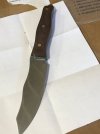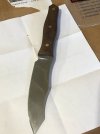-
The BladeForums.com 2024 Traditional Knife is ready to order! See this thread for details: https://www.bladeforums.com/threads/bladeforums-2024-traditional-knife.2003187/
Price is$300$250 ea (shipped within CONUS). If you live outside the US, I will contact you after your order for extra shipping charges.
Order here: https://www.bladeforums.com/help/2024-traditional/ - Order as many as you like, we have plenty.
You are using an out of date browser. It may not display this or other websites correctly.
You should upgrade or use an alternative browser.
You should upgrade or use an alternative browser.
Hollow grind or flat for beginners? Finished pics added.
- Thread starter kdnolin
- Start date
- Joined
- May 31, 2016
- Messages
- 485
It would depend on your setup, but flat grinds are mechanically easier to grind by hand on a 2x72. On a 4x they are much harder. Especially if the platen does not end abruptly and the grinder sit vertical.
- Joined
- Oct 17, 2007
- Messages
- 4,246
I started out hollow grinding on a home built NWGS. I later moved to flat grinding, and at first it seemed more difficult to me, personally. I’ve heard the opposite is true for other makers though.
I think setup/machines will play a factor, but both grinding methods do have a lot in common.
I think setup/machines will play a factor, but both grinding methods do have a lot in common.
- Joined
- Feb 27, 2006
- Messages
- 5,191
i think they are both equally difficult 
Stacy E. Apelt - Bladesmith
ilmarinen - MODERATOR
Moderator
Knifemaker / Craftsman / Service Provider
- Joined
- Aug 20, 2004
- Messages
- 37,925
I suggest flat. You have to master grinding, and getting a smooth and even surface, as well as learn how to control the grind. Starting with flat eliminates one more dimension to learn at first.
Personally, I don't like hollow grinds except urasuki. A few large knives can benefit from them, but a proper FFG is just as good on 95% of all knives ( straight razors excepted).
Personally, I don't like hollow grinds except urasuki. A few large knives can benefit from them, but a proper FFG is just as good on 95% of all knives ( straight razors excepted).
kuraki
Fimbulvetr Knifeworks
- Joined
- Jun 17, 2016
- Messages
- 4,679
It may be different for everyone but I find hollow grinds to be easier to do consistently than flat grinds. The sharper the hollow (smaller the wheel) the easier they get. For me, "ease" means contact area, and once an initial grind is laid down, I typically "follow" what that grind is. Hollow grinds, while not very tall, by being concave give points of contact that are relative to more axis than a flat grind. I don't know how to say that exactly so I'll use a metaphor: Draw a line with your finger across a flat plate, then trace a straight groove like a fuller with your finger. Which was easier to move your finger in a straight line? That's how hollow grinding feels to me. It gets a little harder out at the tip, depending how you do the tip, but still overall easier. It begins getting a little tougher or closer to a flat grind in ease at 14"+ wheels for me, as the hollow flattens out.
So for me, grinds in order of easiest to hardest are:
1. Hollow (6" to 12")
2. Full flat grinds 1" or taller (or convex grinds)
3. Hollow (>12")
4. Saber or scandi grinds that are flat but <1" tall
5. Swedges whether flat or hollow, that are even shorter yet.
I can walk up to the grinder with a forged knife and no good reference lines and grind out a FFG just how I want, now, after 100+ knives; but I still use the bubble jig to do swedges. It's all about surface contact for me to be consistent.
That said I don't do many hollow grinds and agree with Stacy that learning flat is the way to start. Hollow grinds are project specific for me.
So for me, grinds in order of easiest to hardest are:
1. Hollow (6" to 12")
2. Full flat grinds 1" or taller (or convex grinds)
3. Hollow (>12")
4. Saber or scandi grinds that are flat but <1" tall
5. Swedges whether flat or hollow, that are even shorter yet.
I can walk up to the grinder with a forged knife and no good reference lines and grind out a FFG just how I want, now, after 100+ knives; but I still use the bubble jig to do swedges. It's all about surface contact for me to be consistent.
That said I don't do many hollow grinds and agree with Stacy that learning flat is the way to start. Hollow grinds are project specific for me.
- Joined
- Jun 11, 2006
- Messages
- 8,647
I started with hallow grinding and did so many I got bord and switched to flat. But I find my self being drawn back to hallow grinding. But it’s more of a product of the need for increased production. If flat grinding I do a hand rubbed finish. I normally leave a machine finish on a hallow grind like this one. And it’s quick to do and looks good.


- Joined
- Jul 1, 2013
- Messages
- 32,479
I do all Full Flats.. I like that there isn’t a thick part of the top of Hollow grinds .. I can see how hollows work well for some butcher, hunting knives. For Culinary, especially with chopping thru vegetables. I see a FFG working better and they do excellent on meats and fish...IMO
- Joined
- Oct 17, 2007
- Messages
- 4,246
No reason you can't try a couple of each and see which one feels better. Get some scrap flat bar from a local yard or fab shop and go to town.Thanks for the advice. I will be trying FFGs and if that works for me, I’ll stay away from hollow grinds for now.
I started with hallow grinding and did so many I got bord and switched to flat. But I find my self being drawn back to hallow grinding. But it’s more of a product of the need for increased production. If flat grinding I do a hand rubbed finish. I normally leave a machine finish on a hallow grind like this one. And it’s quick to do and looks good.

The "JT wrap"! I used to have your "how to" video downloaded to my hard drive, but it got corrupted.
Anyway, that's a fine lookin blade.
Last edited:
- Joined
- Jun 11, 2006
- Messages
- 8,647
JT, that is the look I would like to do, eventually. Beautiful blade!!!
Very nice
Thanks guys, been doing this blade style for a long long time and it’s still a fan favourite. It’s funny becaus one of these came up for sale the other day 2nd hand and sold in under an hr.
As a new person to knife grinding I have found them both to be equally difficult/easy. There is a learning curve to each which has to be overcome. Neither of which is easier or more difficult. I know, this is a crazy description, but I found that once making the attempt there was a learning curve to each style. Neither impossible, just different.
- Joined
- Nov 9, 2006
- Messages
- 521
I am a beginner with both flat platen and 10" wheel. If you have both, I suggest trying both out and go back and forth. I have made 3 to 4 of the same blade profile and done some hollow and another flat back to back. One thing to keep in mind is to look at a hollow ground calculator like this one . The height you can go with your wheel will be limiting based on the concept in the calculator.
In my experience, both hollow and flat are hard for me to start. Once I can get an initial hollow going, it is easier to find it. The blade sort of sucks into it and is easier for me up to a certain time. As someone else said, I find it more difficult to finish the hollow grind at the tip as well as near the ricasso. It just seems harder for me to get the grind lines out from previous grits. I have burned through tips more often with hollow than flat.
My flat grinding improved when I got an platen made from A2. Another thing I've done was start with small knives (height wise) thinking they were easier with less material. But the taller the knife is, the more flat there is that you can get a feel for.
In my experience, both hollow and flat are hard for me to start. Once I can get an initial hollow going, it is easier to find it. The blade sort of sucks into it and is easier for me up to a certain time. As someone else said, I find it more difficult to finish the hollow grind at the tip as well as near the ricasso. It just seems harder for me to get the grind lines out from previous grits. I have burned through tips more often with hollow than flat.
My flat grinding improved when I got an platen made from A2. Another thing I've done was start with small knives (height wise) thinking they were easier with less material. But the taller the knife is, the more flat there is that you can get a feel for.
- Joined
- Apr 3, 2011
- Messages
- 5,792
I agree with Stacy on this one. Hollow grinding adds one more dimension to grinding. You have to either have experience or a 'hollow grinding calculator' to know what wheel to use when. When you are hollow grinding, you have to factor in the stock thickness, grind height, and bte (behind the edge) thickness before you can really assess which wheel to use. For example, if you try to do a full height hollow grind with a 6" wheel on a 1.5" blade, it won't work - even if it's .25" thick blade stock. In other words, hollow grinds become 'maxed out' at a certain level, whereas with a flat grind you could simply bump the grind height up or the edge back a little (if a hollow grind is at it's max then even if you grind the edge flat to make it thicker it won't make it thicker until you remove a LOT).
So basically, a good hollow grind, in my opinion, is more difficult to do than a good flat grind. just my .02!
So basically, a good hollow grind, in my opinion, is more difficult to do than a good flat grind. just my .02!


